Six Beautiful Butterflies that Call New Jersey Home
A Closer Look at Six At-Risk Butterflies Found in the Garden State
By: Kathleen Wadiak, Wildlife Conservation Intern
New Jersey is home to a number of butterfly species as diverse as the different habitats throughout the state. Whether you live by the shore, a forest, or open fields, you can find a few of these species during their flight period, which usually takes place during the summer months. While it is no secret that the state can be home to well-known butterflies such as the Monarch, here are six butterflies that also call New Jersey home.
Baltimore Checkerspot
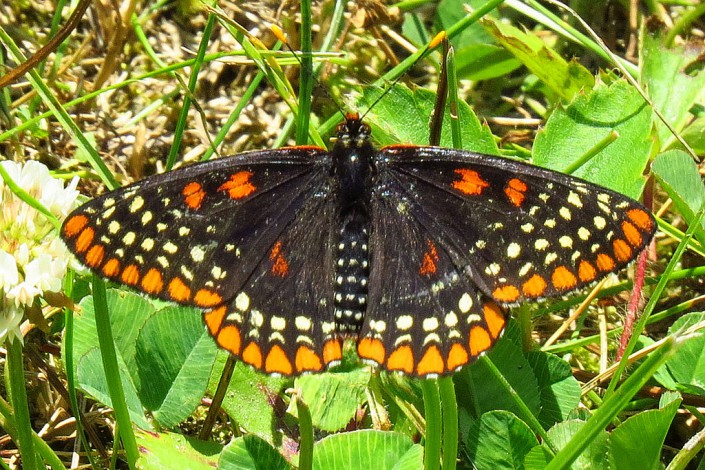
The best time to see a Baltimore checkerspot is early June to early August. This medium-sized butterfly a wingspan of about 1 ½ to 2 ½ inches. They are black with an orange border and speckled with white and orange markings. Checkerspots can be found in the northern half of the state in wet, stream-fed meadows consisting of mostly tall herbaceous growth. White turtlehead is a necessity in its habitat as it is the food source for developing caterpillars. The checkerspot’s unique environmental needs make it particularly vulnerable to habitat destruction and fragmentation.
Compton Tortoiseshell
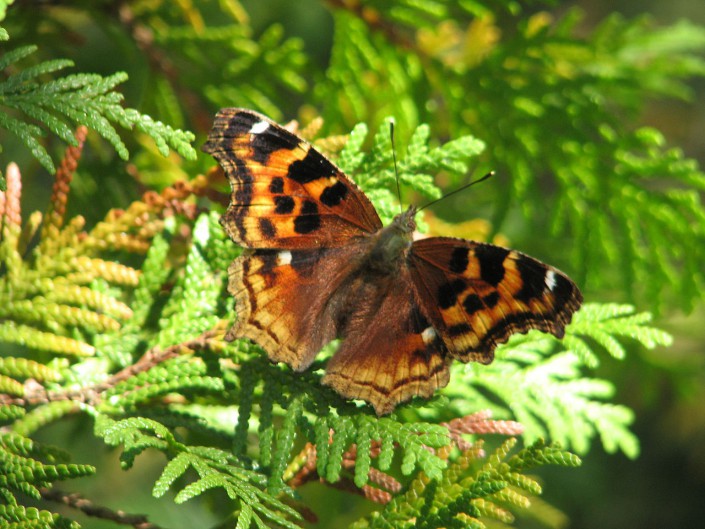
Compton tortoiseshell butterflies have a flight period of March to November, during which they can be found in northeastern New Jersey in mixed and deciduous forests. In the forests, they make use of shelters created by tree cavities and nearby building eaves. Compton tortoiseshells can be identified by their orange-brown, black spotted wings with both the forewings and hindwings having a single white spot on the leading edges. The undersides of the wings are mottled gray brown with a small white “V.” With a wingspan of 2 ½ to 3 inches, they are a relatively large butterfly. The majority of this butterfly’s diet consists of rotting fruit and sap. Populations often fluctuate dramatically from year to year depending on habitat quality and climate factors.
Eyed Brown

Sightings of eyed browns occur from early June to late July in northeastern New Jersey, with most reports coming from Sussex County. They occupy open wetlands including sedge meadows, cattail marshes, and tall grasses alongside slow-moving streams where there are sedges for its caterpillars to feed on. Adults feed on rotting fruit, sap, and bird droppings. The eyed brown gets its name from its wings. About 1 ½ to 2 ½ inches across, they are pale brown, with the color darkening toward the body. On both sets of wings, there are black “eye” spots that are larger on the hindwing. The undersides of the wings are also pale brown, but have jagged lines running across them.
Hickory Hairstreak
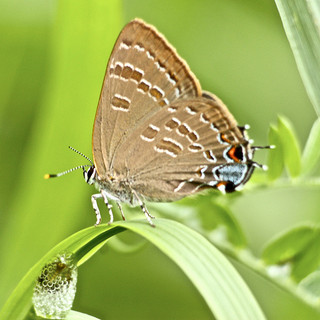 Hickory hairstreaks can be seen from mid-June to early August in the northern half of the state. Their habitat consists of deciduous and second growth forests and adjacent fields. The forests in its habitat almost always consist of hickory trees, as they are the primary food plant of its caterpillars. Adult butterflies feed on the nectar of a variety of flowering plants including common milkweed, New Jersey tea, and white sweet clover. The hickory hairstreak is a relatively small butterfly with a wingspan of approximately 1 to 1 ½ inches. It is rarely seen with its wings open and is identified by the dark postmedian “dashes” and white outline on the underside of its grayish brown wings. On the hindwing, there is a pale blue patch that extends inward further than the adjacent orange and black spots. There is one tail on each hindwing.
Hickory hairstreaks can be seen from mid-June to early August in the northern half of the state. Their habitat consists of deciduous and second growth forests and adjacent fields. The forests in its habitat almost always consist of hickory trees, as they are the primary food plant of its caterpillars. Adult butterflies feed on the nectar of a variety of flowering plants including common milkweed, New Jersey tea, and white sweet clover. The hickory hairstreak is a relatively small butterfly with a wingspan of approximately 1 to 1 ½ inches. It is rarely seen with its wings open and is identified by the dark postmedian “dashes” and white outline on the underside of its grayish brown wings. On the hindwing, there is a pale blue patch that extends inward further than the adjacent orange and black spots. There is one tail on each hindwing.
Northern Oak Hairstreak
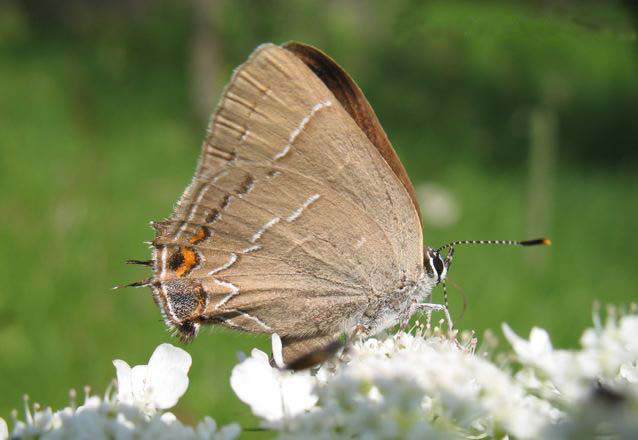
The flight period of the northern oak hairstreak lasts from mid-June to mid-July, during which they can be spotted in southern New Jersey oak forests and adjacent openings. Caterpillars of the northern oak hairstreak feed on the leaves of various oak species while adults feed on the nectar of flowers including New Jersey tea, milkweed, meadowsweet, and maleberry. The northern oak hairstreak is a small butterfly with a wingspan of approximately 7/8 to 1 ½ inches. The underside of the forewing and hindwing is gray-brown and has black and white, narrow postmedian bands, which form an “M” on the hindwing. There is a blue tail spot on the hindwing that is capped by orange and black. Each hindwing has one tail.
Rare Skipper
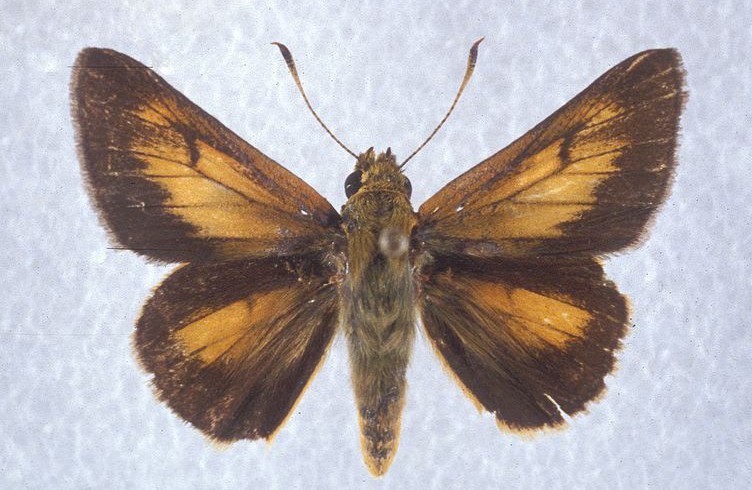
The rare skipper can be found along the southern coastal regions of New Jersey from May to September. Instances of rare skipper populations occur on a very local basis, and very little is known about the species. Their habitat consists of fresh and brackish wetlands along tidal rivers and marshes as well as abandoned rice paddies further inland. Caterpillar host plants include tall cordgrass in northern and coastal habitats and giant cutgrass in some southern wetland areas and abandon rice paddies. Adult rare skippers feed on nectar from wetland flowers such as swamp milkweed and pickerelweed. Rare skippers can be identified by their bright yellow-orange wings with a broad, dark border around the upper-side of the forewing and hindwing.
Kathleen Wadiak is a Wildlife Conservation Intern with the Conserve Wildlife Foundation of New Jersey.